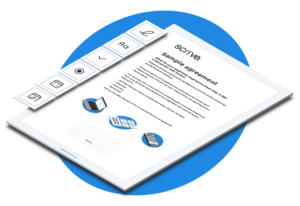Outdated concepts around qualified signatures
Qualified electronic signatures (QES) used to be seen as:
- a hassle for your customers
- expensive for your business
- only legally required in a few use cases
Scrive QES allows signatories to sign an agreement in seconds using BankID or any of the numerous national electronic ID methods (eIDs) that conform to the standards set forth under eIDAS, the EU regulation that defines the framework for electronic signatures and eIDs.
So for the same effort it takes to sign with an Advanced Electronic Signature (AES), you get a Qualified Electronic Signature (QES), the highest level of reliability and legal recognition per eIDAS.
You need to accept marketing cookies to see the video.
Read more about our third party solutions in the eID hub
This question used to be a valid one, but Scrive’s QES solution changes the conversation. With the same user experience as Advanced Electronic Signature (AES), there’s no reason not to adopt QES in your agreement workflows.
Adopting QES in your agreement signing workflows lets you:
Scrive’s QES solution makes qualified electronic signatures simple and affordable so you can future-proof your business with the highest level of reliability and legal recognition across the EU. As a Qualified Trust Services Provider (QTSP) under the eIDAS regulation, Scrive helps you build customer trust while staying compliant.

Qualified electronic signatures (QES) used to be seen as:
But Scrive has transformed this experience, offering a user-friendly, cost-effective QES solution that provides the same legal recognition as a handwritten signature:

QES is becoming the default choice for secure and compliant electronic signatures. With Scrive QES, you can meet today’s highest security and regulatory requirements while being prepared for future changes—all with a simple, cost-effective solution. Future-proof your business with QES now
Want to experience Scrive’s QES solution for yourself?


Across the EU, there’s a growing trend towards making QES the gold standard for signing legally binding agreements. Examples include:

First, what is a qualified electronic signature? QES is the only type of electronic signature that can always be relied upon to have the same legal validity of a handwritten (“wet”) signature.
By legal requirements, a QES must be created by a Qualified Signature Creation Device (QSCD), and be based on a qualified certificate for electronic signatures. These requirements are the responsibility of the e-signature service provider and their partners, not the parties signing the document.
Most QES solutions combine the identity proofing method with the signature. By contrast, Scrive QES is based on the issuance of short-term qualified certificates that are created with eIDs notified according to the eIDAS (currently supporting Swedish BankID). This enables Scrive QES to be used with ease across borders within the EU, allowing users from any member state to sign the same document. Other benefits include: